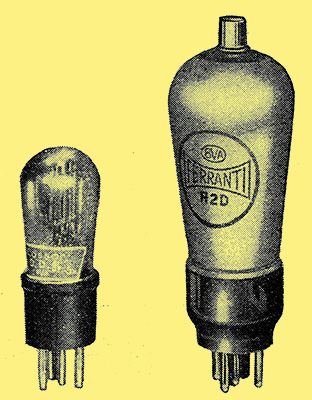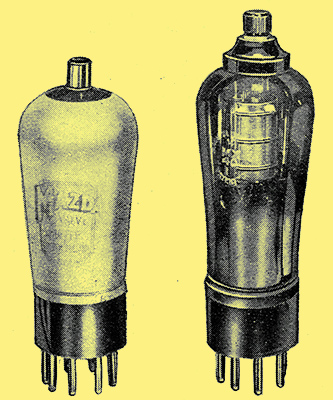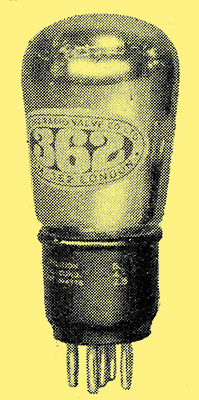|

(L) Cossor duo-diode, (R) Ferranti H2D duo-diode triode.
One of the chief developments of recent months has been the production of universal valves, and specimens will be found on the stands of many firms. The valves are all of the indirectly-heated type and they are intended to be operated with their heaters connected in series. Each range, therefore, is designed for constant current rather than constant voltage operation.
Marconi and Osram will be showing a range which includes a heptode, a variable-μ HF pentode, a triode, a duo-diode triode, and an output pentode, and each valve has a heater rated for 13 Volts at 0.3 Ampere. The rectifier in the series, the U30, takes the same current, but is rated for 26 Volts. A type 301 Barretter for heater current regulation will also be available.
Universal valves of similar heater ratings will also be found on the Ferranti stand, but the Mazda and the Mullard types are all designed for a current of 0.2 Ampere only. The Mazda VP1321 is an HF pentode with a screen-grid designed for operation at 250 Volts, so that a screen-feed potentiometer is unnecessary. Its heater is rated at 13 Volts, and it has a mutual conductance of 2.7 mA/V. The VP1320 is a similar valve, but designed for working at a somewhat lower screen voltage. A triode-pentode valve is included in the range, and has a 26 Volts heater, while other valves comprise a duo-diode, a duo-diode-triode, a duo-diode-output pentode of high efficiency, and rectifiers.
The Mullard range comprises an octode frequency-changer, HF pentodes of both plain and variable-μ types, a duo-diode, an output pentode and a rectifier. The control grid, in all valves is brought out to a top cap and gold metallising is used, While this series is fitted with special side-contact bases instead of the familiar pins.

(L) Mazda AC/TP frequency-changer, (R) Osram MX40 Heptode.
Although it seems probable that such valves will in time supersede the ordinary AC and DC types, these are still continued, and many new additions are being made to the AC ranges. Practically every firm will have a special frequency-changer valve, and Marconi and Osram have the X21 and the MX40 heptodes for battery and AC operation respectively. The Ferranti VHT2 and VHT4 heptodes will also be on view, and Cossor will have an AC heptode - the 41MPG. Mullard will be showing an octode, the FC4, this being essentially a heptode with the addition of a suppressor grid, and also the TP4 - a triode-pentode. This type of valve falls into the multiple, as distinct from the multi-electrode, class, for it consists of a separate triode and pentode built into the same bulb. It functions, therefore, in a. manner identical with that of the conventional two-valve frequency changer, but has the advantage that the valves are specially designed for the work which they are called upon to perform. Mazda frequency-changers are also of the triode-pentode type, and several models will be shown - the AC/TP for AC working, the TP22 for battery sets, the TP2620 in the Universal range, and the TP1340 for car radio.
Duo-diodes have been introduced by Cossor, Mazda, and Mullard, and it is claimed that they can handle a larger input than the small diodes fitted in valves of the multiple-diode type. Their use in the larger class of receiver, therefore, may prove advantageous. Few additions have been made recently to this multiple diode class, so that the introduction oi separate duo-diode valves .might lead one to believe that the limit has been reached here.
In battery valves Marconi and Osram will show at variable-μ screen-grid valve, a triode, and an output pentode in which certain details, but not the external anode, of the Catkin construction have been adopted. The QP21 double output pentode for quiescent push-pull will also be on view. This valve has an output of about 1 Watt and can be fed from any push-pull transformer. A double-pentode of similar type, but with both screen-grids brought out to separate contacts, will be shown by Mazda; this valve has a 9-pin base.
Mullard have produced a Class B valve designed for operation with negative grid bias and capable of an output of about 1,500 milliWatts, and their range of battery valves has been extended by the inclusion of pentodes. A Class B valve in the 362 range, the BX2, is rated for the unusually large output of 3 Watts, but it requires an anode potential of 180 Volts and a signal input of 40 Volts peak. A QPP double- pentode will be found on the Hivac stand, and among a wide range of all types is a combined driver and Class B valve. This consists oi three triodes built into a single glass envelope. One triode forms the driver valve, and the other two are connected in push-pull to make the familiar double-triode used for Class B amplification.
HF pentodes have in the past been characterised by higher grid-anode capacities than screen-grid types, but in the Marconi and Osram VMP4/K the commendably low figure of 0.002 μF has been reached. This valve is of the Catkin type. Another new product, of these firms is the PX25A, a valve of similar characteristics to the well-known PX25, but designed especially for push-pull operation, and a pair of them will give an output of no less than 16.5 Watts.

The 362 output triode.
|